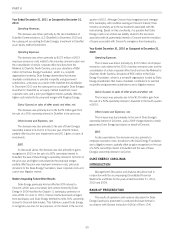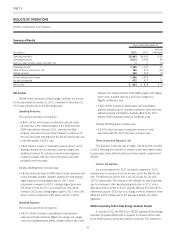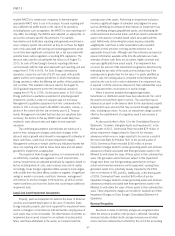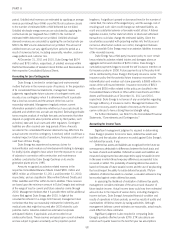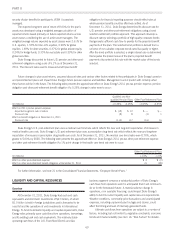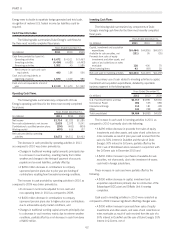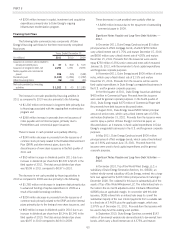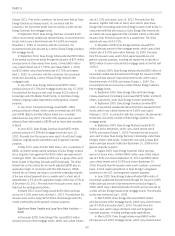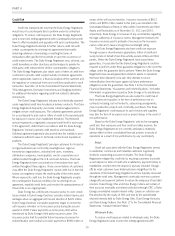Duke Energy 2011 Annual Report Download - page 80
Download and view the complete annual report
Please find page 80 of the 2011 Duke Energy annual report below. You can navigate through the pages in the report by either clicking on the pages listed below, or by using the keyword search tool below to find specific information within the annual report.
PART II
security of plan benefits for participants. VEBA I is passively
managed.
The expected long-term rate of return of 8.00% for the plan’s
assets was developed using a weighted average calculation of
expected returns based primarily on future expected returns across
asset classes considering the use of active asset managers. The
weighted average returns expected by asset classes were 2.61% for
U.S. equities, 1.50% for Non-U.S. equities, 0.99% for global
equities, 1.69% for debt securities, 0.37% for global private equity,
0.24% for hedge funds, 0.30% for real estate and 0.30% for other
global securities.
Duke Energy discounted its future U.S. pension and other post-
retirement obligations using a rate of 5.1% as of December 31,
2011. The discount rates used to measure benefit plan benefit
obligations for financial reporting purposes should reflect rates at
which pension benefits could be effectively settled. As of
December 31, 2011, Duke Energy determined its discount rate for
U.S. pension and other post-retirement obligations using a bond
selection-settlement portfolio approach. This approach develops a
discount rate by selecting a portfolio of high quality corporate bonds
that generate sufficient cash flow to provide for the projected benefit
payments of the plan. The selected bond portfolio is derived from a
universe of non-callable corporate bonds rated Aa quality or higher.
After the bond portfolio is selected, a single interest rate is determined
that equates the present value of the plan’s projected benefit
payments discounted at this rate with the market value of the bonds
selected.
Future changes in plan asset returns, assumed discount rates and various other factors related to the participants in Duke Energy’s pension
and post-retirement plans will impact Duke Energy’s future pension expense and liabilities. Management cannot predict with certainty what
these factors will be in the future. The following table presents the approximate effect on Duke Energy’s 2011 pre-tax pension expense, pension
obligation and other post-retirement benefit obligation if a 0.25% change in rates were to occur:
Qualified and Non-
qualified Pension Plans Other Post-Retirement Plans
(in millions) +0.25% -0.25% +0.25% -0.25%
Effect on 2011 pre-tax pension expense
Expected long-term rate of return $ (12) $ 12 $ — $ —
Discount rate (8) 8 (1) 1
Effect on benefit obligation at December 31, 2011
Discount rate (114) 117 (16) 16
Duke Energy’s U.S. post-retirement plan uses a medical care trend rate which reflects the near and long-term expectation of increases in
medical health care costs. Duke Energy’s U.S. post-retirement plan uses a prescription drug trend rate which reflects the near and long-term
expectation of increases in prescription drug health care costs. As of December 31, 2011, the medical care trend rates were 8.75%, which
grades to 5.00% by 2020. The following table presents the approximate effect on Duke Energy’s 2011 pre-tax other post-retirement expense
and other post-retirement benefit obligation if a 1% point change in the health care trend rate were to occur:
Other Post-Retirement Plans
(in millions) +1.0% -1.0%
Effect on other post-retirement expense $2 $(2)
Effect on other post-retirement benefit obligation at December 31, 2011 31 (28)
For further information, see Note 21 to the Consolidated Financial Statements, “Employee Benefit Plans.”
LIQUIDITY AND CAPITAL RESOURCES
Overview
At December 31, 2011, Duke Energy had cash and cash
equivalents and short-term investments of $2.3 billion, of which
$1.0 billion is held in foreign jurisdictions and is forecasted to be
used to fund the operations of and investments in International
Energy. To fund its domestic liquidity and capital requirements, Duke
Energy relies primarily upon cash flows from operations, borrowings,
and its existing cash and cash equivalents. The relatively stable
operating cash flows of the U.S. Franchised Electric and Gas
business segment compose a substantial portion of Duke Energy’s
cash flows from operations and it is anticipated that it will continue to
do so for the foreseeable future. A material adverse change in
operations, or in available financing, could impact Duke Energy’s
ability to fund its current liquidity and capital resource requirements.
Weather conditions, commodity price fluctuations and unanticipated
expenses, including unplanned plant outages and storms, could
affect the timing and level of internally generated funds.
Ultimate cash flows from operations are subject to a number of
factors, including, but not limited to, regulatory constraints, economic
trends and market volatility (see Item 1A. “Risk Factors” for details).
60


